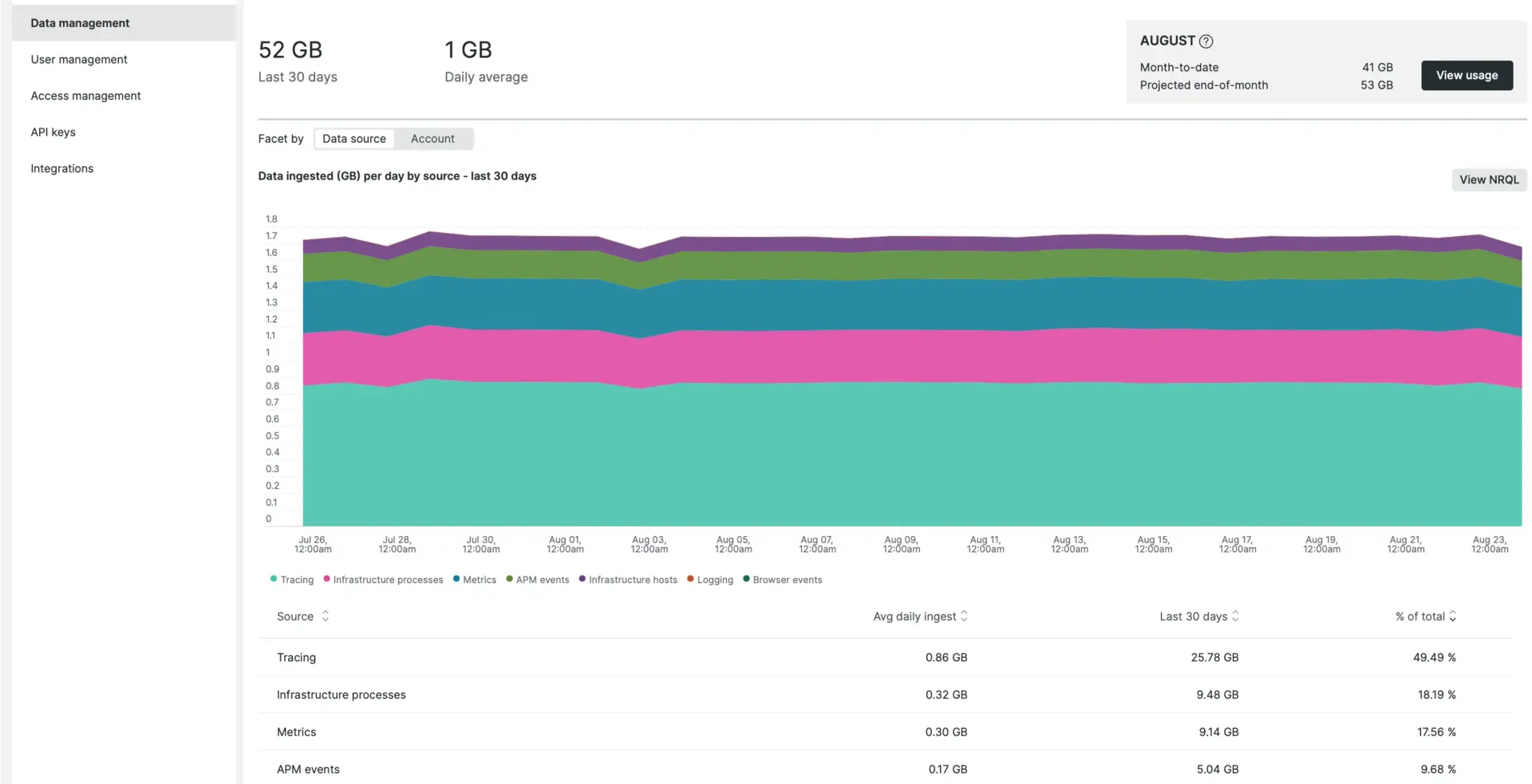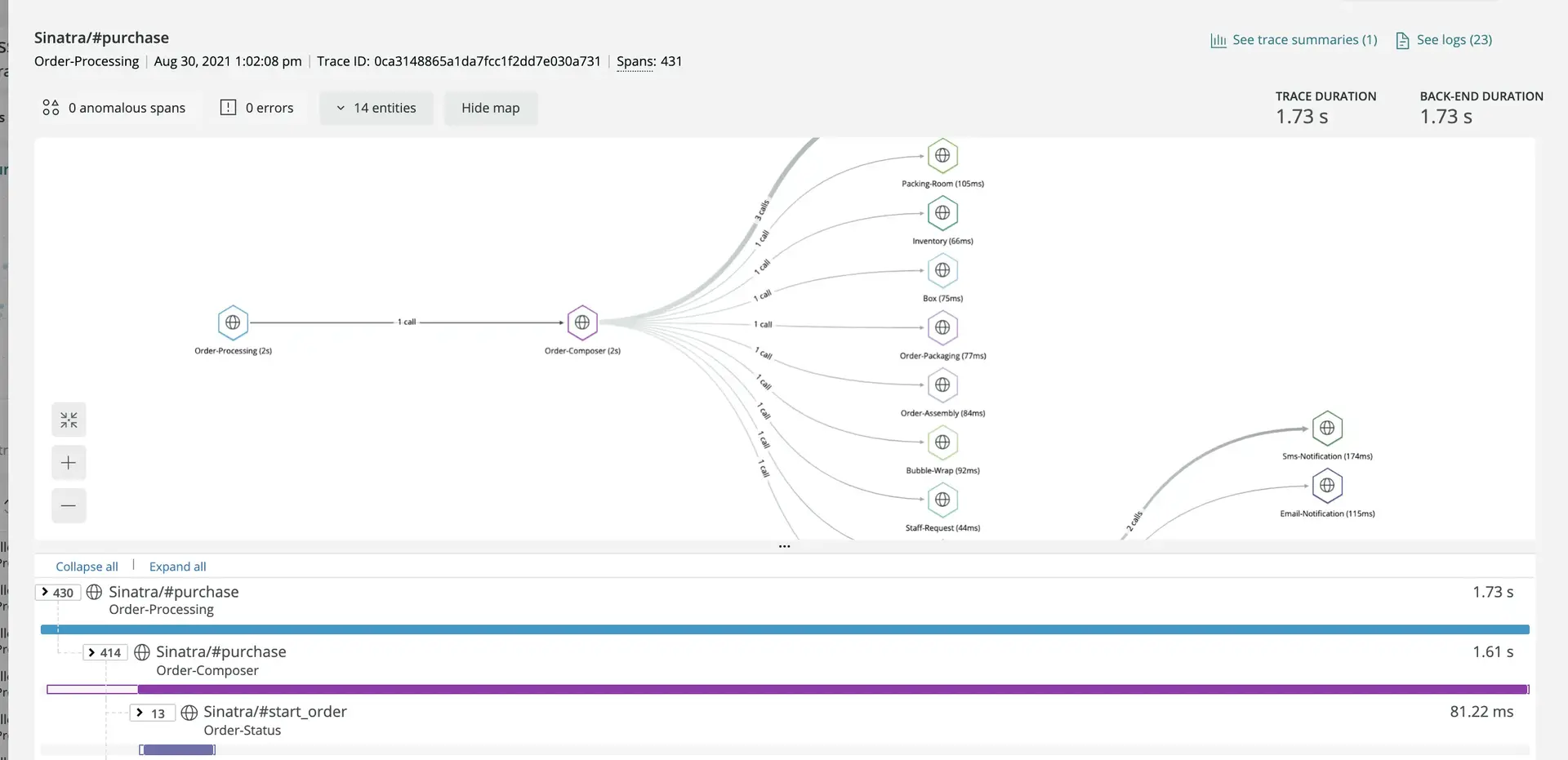This is the first part of our implementation guide.
When you first sign up for New Relic, there are some important account- and user-related decisions to make. In this stage of the implementation, you'll:
- Decide on some important account-related settings
- Think about who your New Relic team leads will be
- Think about what components in your system you should instrument
- Think about some strategies for organizing your data
Initial account setup
When you sign up for New Relic, you get a New Relic organization. This organization is the container for your organization's data, accounts, and users. Here are some important initial things to consider.
Decide on data center region
When you sign up for New Relic, you must choose which of our two data center regions your organization will be in: US or EU. There are some differences between the regions: for example, they have different API endpoints, and have some feature differences. Learn more about data center regions.
Think about the edition you'll need
A New Relic organization can use New Relic free, forever. When a New Relic organization starts to pay for New Relic, it can be on one of three editions: Standard, Pro, or Enterprise. You can always upgrade your edition later, but for larger organizations it may make sense to look at the editions to understand the features of each and which you'll likely end up on: see our pricing page.
Decide on security compliance needs
New Relic offers a high level of security by default (read more about our security features). But certain industries require much higher levels of security compliance (for example, healthcare and financial institutions). For these organizations, we offer FedRAMP and HIPAA security compliance. These compliance options require both Enterprise edition (learn more about editions) and our Data Plus option. Data Plus gives you access to some powerful data features, like increased retention and higher query limits. Read more about the benefits of Data Plus.
For more on our compliance features, see the docs:
Decide on team leads
You'll want to decide which of your team members will be your initial New Relic team leads. These will be the team members who do one or more of the following:
- Set up and configure instrumentation
- Add and manage New Relic users
- Oversee billing
- Train your users and answer questions
Here are some things to consider when adding team leads:
- Assign user type based on expected duties. For administrative duties, you must make your users either core or full platform users. Learn more about user type.
- Assign users to appropriate groups. Options for adding admins to groups:
- Add them to the default Admin group, which gives access to everything.
- Give them the Group admin role, which grants them ability to add/remove users for specific groups.
- Create a custom group.
We recommend using a spreadsheet to plan out your users' New Relic responsibilities.
Understand billing
Your team should have an understanding of what the billing factors are and what you get for free.

The usage UI shows you your ingest data.
Want to estimate future costs? See our blog post on ingest estimation.
Think about instrumentation goals and plans
To get the most out of New Relic, you'll want to spend some time thinking about your observability goals and what you'll need to instrument to achieve those goals. The larger your organization is, the more important this planning is.

A view of our distributed tracing UI. The more system components you instrument, the more complete your visibility will be and the more effective your observability efforts will be.
Some tips for getting more clear about your instrumentation plans:
- Brainstorm what your observability goals are and how you'll achieve them. What are the main business units involved? What are the key performance indicators you'll use to measure success?
- If you've used other monitoring solutions in the past, think about what the pain points have been and how you might you improve things this time around.
- Make a diagram of your system architecture, both hardware and software. What components are on-premises versus in the cloud? Decide what entities (apps, hosts, services, etc.) you'll need to monitor to achieve your goals.
- Create a spreadsheet that maps out your monitored entities and how those relate to your teams or other business units.
- Do you want to use New Relic for all your observability needs? Or are you planning on using a variety of tools? There can be value in switching to New Relic for everything, so that all your data is in one place. Keep in mind you can also forward data from other services to New Relic. (Learn about some common telemetry tools and services we support.)
These are some things you might want to think about. If you'd like in-depth guidance on achieving optimal observability, check out our Observability maturity series (for example, this guide on determining what to instrument).
Think about data organization
The more organized your New Relic data is, the easier it'll be to:
- Search and query your data
- Create for your data
- Troubleshoot a problem
Some important strategies for organizing your data are:
- Use tags to help you quickly see relationships between your monitored entities, which helps you more easily troubleshoot problems. It's important to have a strong tagging strategy. For example, it's good practice to have everyone use the same tag naming structure and consistently use the same tags. If you don't already have one, consider creating a tagging strategy for your organization.
- Use our workloads feature to group related apps, services, hosts, and other entities into business-relevant groupings and see information about them in one dashboard. Spend some time thinking about how you might group related entities into workloads.
We'll mention tags and workloads again later in this guide, but if your organization is large, it might help to do some thinking about these things now.
Consider multiple accounts
Using multiple accounts is another potential way to organize your data.
When you sign up for New Relic, it creates a New Relic organization that has a single account. Pro or Enterprise edition allow you to have multiple accounts: otherwise, you can only have one.
Learn more about why you'd add accounts.
We recommend using a spreadsheet to plan out the accounts you'll need and track the account IDs: this can be the same spreadsheet you use to map out user access.
Understand the available APIs
Understanding some basics about our APIs will come in handy later during instrumentation and configuration. Our APIs include:
- Our data ingest APIs: these are our APIs for our four core data types: metrics, events, logs, and traces. Our data-reporting tools send data via these APIs, and the APIs can also be used directly. Our main data ingest key is the . The license key is tied to a specific account ID. Our more automated install options include the correct license key for you.
- Our GraphQL-format API, which we call NerdGraph. This is used for everything except data ingest, from querying your data to configuring New Relic features. NerdGraph requires a , which is a personal key unique to each user.
Plan out and add users
So far, you've added your New Relic admins but likely haven't added other users yet.
For organizations with roughly 15 users or more, it's helpful to plan out your users' New Relic access. This is especially the case if you require granular control over which accounts and roles your users will be able to access. But if you'll only have a few users, or if you're planning on giving most or all of your users access to all New Relic features, it's less important to plan out user access.
Note that only Pro and Enterprise editions allow multiple accounts, the ability to add custom groups and roles, and the ability to have more than five full platform users. This means that if you have Free or Standard edition, planning out your users is less important.
Some suggested steps:
- Read some basics of how our user management system works.
- Plan out which team members will get access to New Relic, what their user type will be, and what accounts they'll have access to.
Ready to add users? Some options:
- Want to use single sign-on or manage your users from your identity provider? See our user login and management options.
- Want to add users manually from our UI? See Add users.
- Want to programmatically manage accounts and users? See our NerdGraph API docs.
Also note that you can always add users later, after you've got data reporting.
Next stage
Ready to continue on your implementation journey? Go to the next stage: Instrumentation.